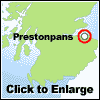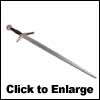
|
Battle of Prestonpans
The Old Pretender had two sons. The elder was Charles Edward, the younger Henry (later a Cardinal). Charles
Edward was a complete contrast to his unlucky and depressing father. He was cheerful, adventurous, and
energetic; he was clearly a born leader, and he looked like a prince of royal blood.
With England heavily involved in a war on the Continent, and thus denuded of troops, 1745 was an obvious time
to pick for a bid to power. In the preceeding year the French had assembled an invasion fleet at Dunkirk, with
every intention of using it, but it had been, once more, destroyed by storms. This was a setback, but Charles was
undeterred. He knew in his bones that he could and must win. The battle of Fontenoy on 11 May 1743 confirmed
his opinion; the English were now in desperate trouble on the Continent, and all he had to do was to show his
face in Scotland and the country would rise to support him.
Glenfinnan had brought him a thousand supporters, and he was soon joined by another three thousand. With
these he moved forward and took Perth. Thence he went to Edinburgh where the city was gained without a fight.
It looked - and not only to him - as if success was in his grasp. The best of the English army was overseas and all
that could be mustered to meet him was an army of less than three thousand, six battalions in all, of which two
were very raw and new.
Commanding them was the incompetent Sir John Cope who had already failed to
intercept him on the road to Edinburgh. Cope had subsequently embarked his army and landed them at Dunbar,
whence he had marched towards Edinburgh. Charles, full of heady triumph, was now moving south - and the two
armies met, on 20 September 1745, at Prestonpans, East Lothian.
As the two armies closed, the highlanders moved
on to the higher ground around Tranent and took a long careful look at their opponents. The sight was not
encouraging. Knowing their deficiencies in arms, without artillery, and mainly armed with broadsword or
makeshift pike, the prospect of a successful charge over rough and unknown ground looked doubtful. Impetuous
though they were, they were not suicidal.
Charles Edward, however, was burning for action. He rode restlessly here and there, hoping to hit on a plan
which would convince the more cautious of his advisers. Luckily for him he encountered a man named
Anderson, who lived nearby and was a keen Jacobite. Anderson gave Charles Edward a vital piece of
information: it was that a path ran through the bog which was partially protecting Cope's front. If the Young
Pretender used this path he could take his whole army round to Cope's eastern flank, where, because of the
protection of the bog, the latter's dispositions were thinnest.
The latter, moving briskly towards the coast at Cockenzie,
turned west along the line of the present B6371. Their achievement in crossing such rough country so easily is
not now so well appreciated, as the long ditch which could have been such a formidable obstacle has been
largely filled in; the presence of a road, a railway track, pylons, and a huge slag heap makes an appreciation of
the 1745 terrain difficult though not impossible.
As the sun came up, and shone directly into the eyes of Cope's soldiers, he was still trying to make the most of
his new position. On his right he had his artillery, all too close to the Jacobites. Behind were his raw dragoons
whose task was to intercept any attack and break it up. Four hundred yards separated the two armies and, as the
Jacobites checked their positioning, their whole army was gradually edging forward, closing the gap.
On such a small area such a disaster was
all too obvious, even to Cope's centre and left, which were now facing the fury of the Highland charge. Here
again there was no chance to make use of their muskets before they too were overwhelmed; it was short
bayonet against long pike and whirling claymore. Cope's men were like a skilled boxer who is trying to fight off a
heavy puncher who is inside his guard. As they reeled back, the Macdonalds on the highland right, a little late to
begin but devastating now they were on the move, swept diagonally into Cope's army crumpling up its left wing
as they went.
In minutes the battle was lost, but not over. The remainder of the dragoons also tried to escape but now found
their way blocked by fallen or fleeing infantry. The Jacobites too were among them, unhorsing them and slashing
them down with claymores. Colonel Gardiner, still fighting, fell with a dozen wounds. Cope made a desperate
effort to rally some of the dragoons but the best he could do was to take some 400 men out of battle up the
B1349, which was later mockingly christened 'Johnny Cope's road'.
Inevitable English losses were as heavy as
the Scots were light. Five hundred of Cope's army were killed and another 1,500 taken prisoner. In contrast, the
Scots had less than fifty killed and about seventy-five wounded. Much of the slaughter must have taken place
where the A198 is crossed by the B1349, as this is where burial pits were later found.
There are various memorials to the battle in the town. There is a memorial to Col. Gardiner which may be seen
from the road, although it is on the other side of the parallel railway line, and there is another monument on the
A198 junction immediately behind Cockenzie Power Station.
This article was used with permission of Thomas Carrol Woods, webmaster of Prestonpans Links: |
Thursday, December 26th, 2019
Attention visitors: Tartans.com is back. Please note that this is a snapshot of the site as it existed nearly 20 years ago and you may encounter broken links; we are still combing through the site and correcting those as we find them. Please also note that some sections are currently not functional, primarily the discussion forums/clan chat boards.
|
** HOME - First Time Visitors - Glossary - - Contact Us ** Awards | Bibliography | Clan Calendar | Clan Chat | Clan Finder | History | Famous Scots | Genealogy | Great Hall of the Clans | Links | News and Features | Scots on the Net | Search | Site Map The Gathering of the Clans
Copyright 1995- Tartans.com - All Rights Reserved. |




